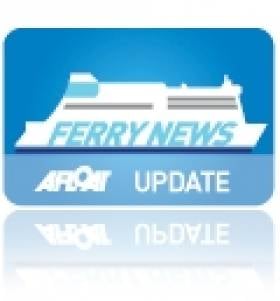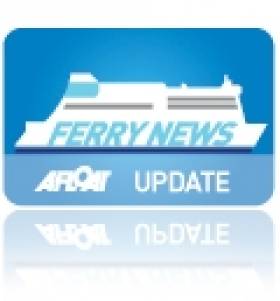Displaying items by tag: Seatruck Precision
Precision Timing as Freight Newbuild Completes Quartet
#FINAL FREIGHT-FERRY – Seatruck Precision has become the final newbuild of a quartet of ro-ro freight-only ferries to enter Irish Sea service for Seatruck Ferries, writes Jehan Ashmore.
The 18,920 tonnes newbuild completed her maiden 'commercial' round-trip, departing Liverpool on Tuesday and returning overnight from Dublin with an arrival on Merseyside early yesterday morning.
She was built by Flensburger Schiffbau-Gesellschaft (FGS), Germany along with her sisters with each having a freight capacity of 2,166 lane metres spread over four decks, carrying 151 (un-accompanied) trailer units. An increase of 36 trailers compared to the quartet of older 'P' class ships.
The FGS quartet are called the 'Heyham'-max series, as they are the largest-ever vessels designed to use the tight confines of the Lancashire port. It is believed that the latest newbuild will be deployed out of the port joining Seatruck Performance, the third newbuild of the series which runs on the route to Dublin.
The remaining pair, Seatruck Power and leadship of the series Seatruck Progress operate on the Dublin-Liverpool route. However as the latter vessel is currently moored at Cammell Laird shiprepair facility in Birkenhead, the newbuild is deputising in her place on the central corridor route.
Seatruck also operate Heysham-Warrenpoint and in May a new route Heysham-Belfast began service.
Another Fine Performance
#SEATRUCK NEWBUILD - With the announcement of Seatruck Ferries new Belfast-Heysham route to open in May, the company have in the meantime introduced a newbuild this week on the Dublin-Heysham route, writes Jehan Ashmore.
Seatruck Performance brings additional capacity to the route to Lancashire and becomes the third newbuild to enter the Irish Sea where her sisters are operating Dublin-Liverpool sailings.
She has a length of 142 m, breadth of 25 m and a capacity of 151 units, which is 35 more than the earlier 'P' Class ships which have shifted elsewhere on the Seatruck network.
The final fourth vessel Seatruck Precision as previously reported is currently under construction at the FGS Flensburg yard in Germany and is expected to make her debut on the Irish Sea in June.
- Seatruck Ferries
- Seatruck Performance
- Seatruck Precision
- Irish Sea freightferry market
- Irish Sea freight haulage market
- Irish Sea roadhaulage sector
- Ports and Shipping News
- DubliLiverpool
- DublinHeysham
- BelfastHeysham
- FGS
- FGS Flensburg
- HeyshamMax newbuilds
- Pclass Seatruck newbuilds
- Port of Heysham
- New Irish Sea freightferry





























































